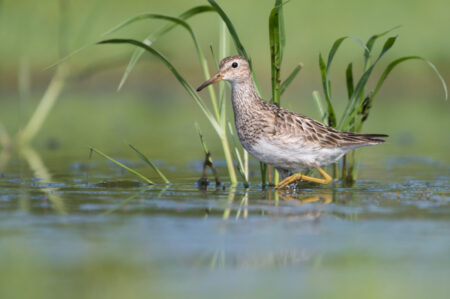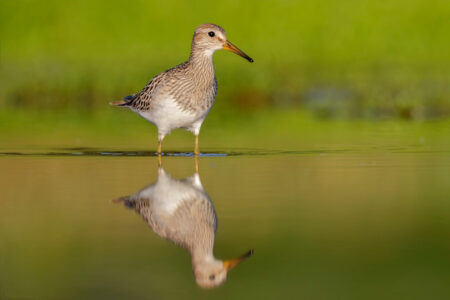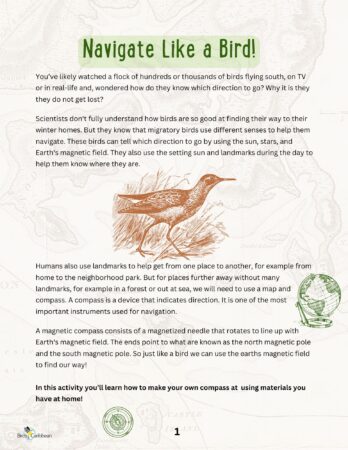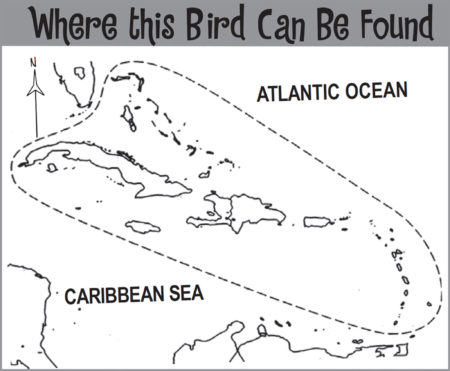Celebrate World Migratory Bird Day (WMBD) with us in 2024! This year’s theme is “Protect Insects, Protect Birds”. Have fun learning about a new migratory bird every day. We have coloring pages, interesting facts, activities, and more. Download for free and enjoy nature with your family at home.
Migratory Bird of the Day: Pectoral Sandpiper
If you’re out birding in marshy, wet, grasslands during migration season, and you see a shorebird’s head pop up — with a slightly down-curved bill — chances are you’ve just spotted a Pectoral Sandpiper! As the medium sized shorebird obligingly steps out of the vegetation you will observe its distinctive, boldly-streaked brown breast. One more stride into the open reveals that this streaky breast pattern ends abruptly — in a stark line marking the start of the white belly and underparts! Pectoral Sandpipers also sport streaked heads and necks, while the feathers on their back and wings are brown with rufous edges. They have shortish yellow-green legs, and are often seen in shallow water or at the water’s edge in grassy vegetation. You might spot them with American Golden Plovers who like similar habitats, and sometimes form flocks with Pectoral Sandpipers.
We all know that many shorebirds are great travelers during migration, but the long-distance journey of the Pectoral Sandpiper is especially amazing! They breed in the high arctic tundra through Siberia and North America, and most of their population winters in South America. Their winter range includes Peru, south Bolivia, south Brazil, Uruguay, south to central Chile, all the way down to southernmost Argentina. This means that some individuals, leaving from the northernmost parts of the breeding range and flying down to the southern tip of Argentina, are making round trip migrations of up to 30,000 km! This is similar to the journeys made by another epic long-distance migrant, the Arctic Tern, and is amongst the longest migrations for a shorebird in the Americas. Pectoral Sandpipers fuel up for these long trips by chowing down on wriggling midge and crane fly larvae.
In fact, Pectoral Sandpipers feast on different types of insects year-round, underscoring our WMBD theme “Protect Insects, Protect Birds”. During fall and winter they can be found in their favorite grassy wet areas — freshwater marshes, pond edges, and flooded agricultural areas. Their love for these environments have earned them the nickname “grasspipers” among birders. They use their down-curved bills to peck at insects at the water’s edge and probe the soft mud, feeling for aquatic insects such as diving beetles, insect larvae of midges and flies, as well as mollusks and worms.
Pectoral Sandpipers are listed by the IUCN as ‘least concern’, but like many shorebirds, their population is unfortunately in decline. Although this shorebird was extensively hunted in North America in the past, this is unlikely to be the cause of the current population decline. The reasons for this present decline are not well understood and need further study, however, it is thought that the loss of freshwater wetlands needed during migration and on their wintering grounds could be part of the problem. Wetland areas supporting thriving insect and invertebrate populations provide essential food for so many of our migratory and resident birds. Keeping wet, grassy areas full of the insects that birds like Pectoral Sandpipers need to thrive can help them on their way during their long migrations! Learn more about this species, including its range, photos, and calls here. Great news! If you’re in the Caribbean, thanks to BirdsCaribbean, you have free access to Birds of the World and you can find out even more in the full species account of this bird!
Thanks to Alex Sansom for the text and Arnaldo Toledo for the lovely illustration!
Color in the Pectoral Sandpiper
Download the Migratory Birds of the Day Coloring Page! Use the picture above and the photos on this page as your guide, or look up pictures of the bird online or in a bird field guide if you have one. Share your colored-in page with us by posting it online and tagging us @BirdsCaribbean #WMBD2024Carib
Listen to the calls of the Pectoral Sandpiper
The calls of the Pectoral Sandpiper is a low, sharp “churt”. This call is quite distinctive and can help identify Pectoral Sandpipers when flushed or in flight.
Enjoy these photos of Pectoral Sandpipers


Activity of the Day
 FOR KIDS: Have you ever wondered how migratory birds like the Pectoral Sandpiper know which direction to go when they hit the skies for their long trips south? And why it is they they hardly ever get lost (unless they get blown off course)!
FOR KIDS: Have you ever wondered how migratory birds like the Pectoral Sandpiper know which direction to go when they hit the skies for their long trips south? And why it is they they hardly ever get lost (unless they get blown off course)!
We don’t yet fully understand how it is that birds are so good at finding their way to their winter homes. But they know that birds can use different senses to help them navigate as they migrate. They can help set their direction using the position of the sun and stars. They can also use landmarks, just like we do, to help them know where they are. One other special way birds can navigate is to use Earth’s magnetic field. Just like birds we can navigate using this magnetic field, unlike birds we cannot sense this ourselves but we can use a magnetic compass.
In our “Navigate Like a Bird” activity You will make your own compass at using materials you have at home! You will need:
- Sewing needle about 1-2 inches long
- Small bar magnet or refrigerator magnet
- A small piece of cork (a flat piece from a wine bottle works but make sure it is cork and not plastic)
- A shallow bowl
- Water
- Pliers
Remember needles are sharp, so you will need a trusted adult to help you with this activity.
FOR KIDS AND ADULTS: Enjoy this video of a Pectoral Sandpiper in the wild!


